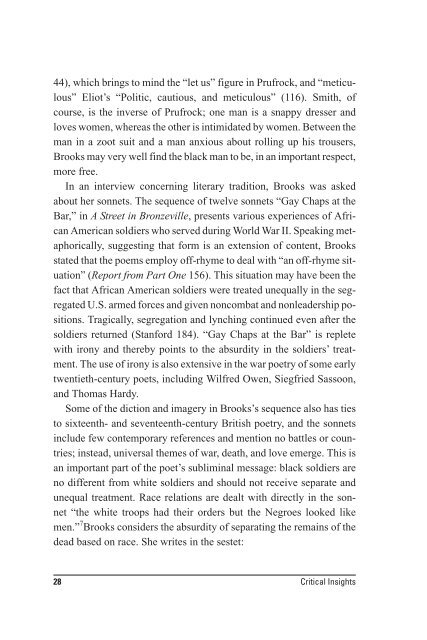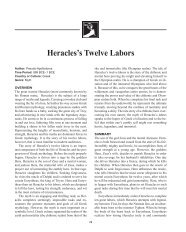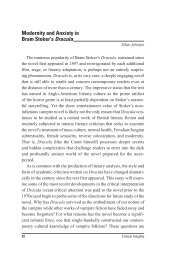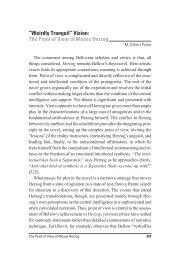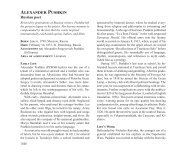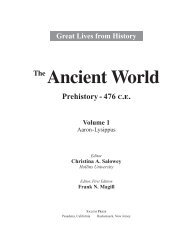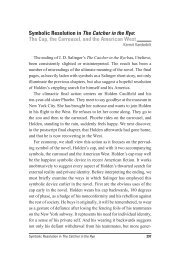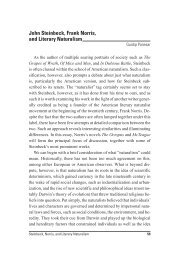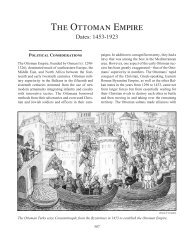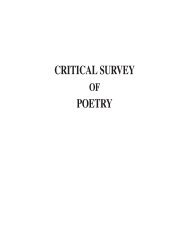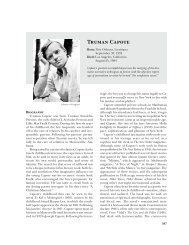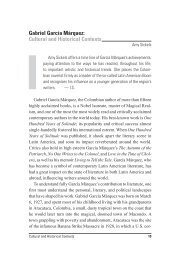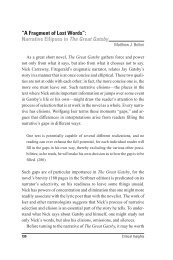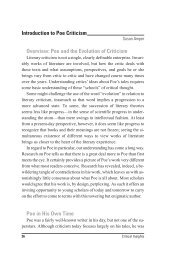The Historical and Social Context of Gwendolyn ... - Salem Press
The Historical and Social Context of Gwendolyn ... - Salem Press
The Historical and Social Context of Gwendolyn ... - Salem Press
Create successful ePaper yourself
Turn your PDF publications into a flip-book with our unique Google optimized e-Paper software.
44), which brings to mind the “let us” figure in Prufrock, <strong>and</strong> “meticulous”<br />
Eliot’s “Politic, cautious, <strong>and</strong> meticulous” (116). Smith, <strong>of</strong><br />
course, is the inverse <strong>of</strong> Prufrock; one man is a snappy dresser <strong>and</strong><br />
loves women, whereas the other is intimidated by women. Between the<br />
man in a zoot suit <strong>and</strong> a man anxious about rolling up his trousers,<br />
Brooks may very well find the black man to be, in an important respect,<br />
more free.<br />
In an interview concerning literary tradition, Brooks was asked<br />
about her sonnets. <strong>The</strong> sequence <strong>of</strong> twelve sonnets “Gay Chaps at the<br />
Bar,” in A Street in Bronzeville, presents various experiences <strong>of</strong> African<br />
American soldiers who served during World War II. Speaking metaphorically,<br />
suggesting that form is an extension <strong>of</strong> content, Brooks<br />
stated that the poems employ <strong>of</strong>f-rhyme to deal with “an <strong>of</strong>f-rhyme situation”<br />
(Report from Part One 156). This situation may have been the<br />
fact that African American soldiers were treated unequally in the segregated<br />
U.S. armed forces <strong>and</strong> given noncombat <strong>and</strong> nonleadership positions.<br />
Tragically, segregation <strong>and</strong> lynching continued even after the<br />
soldiers returned (Stanford 184). “Gay Chaps at the Bar” is replete<br />
with irony <strong>and</strong> thereby points to the absurdity in the soldiers’ treatment.<br />
<strong>The</strong> use <strong>of</strong> irony is also extensive in the war poetry <strong>of</strong> some early<br />
twentieth-century poets, including Wilfred Owen, Siegfried Sassoon,<br />
<strong>and</strong> Thomas Hardy.<br />
Some <strong>of</strong> the diction <strong>and</strong> imagery in Brooks’s sequence also has ties<br />
to sixteenth- <strong>and</strong> seventeenth-century British poetry, <strong>and</strong> the sonnets<br />
include few contemporary references <strong>and</strong> mention no battles or countries;<br />
instead, universal themes <strong>of</strong> war, death, <strong>and</strong> love emerge. This is<br />
an important part <strong>of</strong> the poet’s subliminal message: black soldiers are<br />
no different from white soldiers <strong>and</strong> should not receive separate <strong>and</strong><br />
unequal treatment. Race relations are dealt with directly in the sonnet<br />
“the white troops had their orders but the Negroes looked like<br />
men.” 7 Brooks considers the absurdity <strong>of</strong> separating the remains <strong>of</strong> the<br />
dead based on race. She writes in the sestet:<br />
28 Critical Insights


